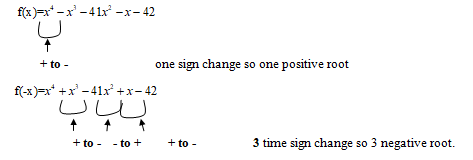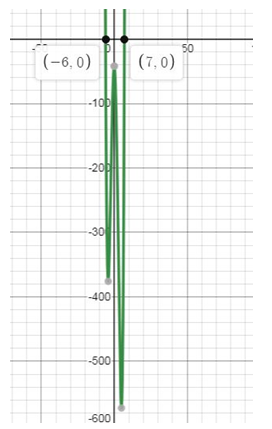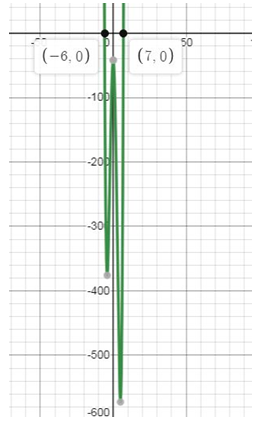
Concept explainers
a.
To find: the possible number of positive negative zeros of function
a.
Answer to Problem 72E
One positive root and three negative roots
Explanation of Solution
Given information:
Concept used:-
Descartes’ Rule: -According to this rule, the number of positive roots of the polynomial is either equal or less than number of sign changes between two consecutive coefficients.
Similarly, for negative roots replace x by −x then count number of sign change and it is either equal or less than number of negative roots.
Calculation:-

b.
possible rational root of function
b.
Answer to Problem 72E
Possible number of rational divisors is 16.
Explanation of Solution
Given information:
Concept Used:-
Possible rational Zeros: - Let P(x) is a polynomial and q is constant term in P(x) and a is leading coefficient of highest degree term in P(x). Then find all possible divisors of q and a and the ratio of these divisors is possible rational roots of P(x).
Calculation:
Possible divisors of constant term -42 of given function are
Possible divisors of leading coefficient term 1 are
So, possible rational divisors of given function are
Possible number of rational divisors is 16.
c.
To draw: the graph of function.
c.
Answer to Problem 72E

Explanation of Solution
Calculation:-

d.
the all real zeros of function.
d.
Answer to Problem 72E
X = -6, 7
Explanation of Solution
Given information:
Function is
Calculation:-
So, real zeros are x = -6, 7.
Chapter 2 Solutions
EP PRECALC.GRAPHING APPR.-WEBASSIGN-1YR
 Calculus: Early TranscendentalsCalculusISBN:9781285741550Author:James StewartPublisher:Cengage Learning
Calculus: Early TranscendentalsCalculusISBN:9781285741550Author:James StewartPublisher:Cengage Learning Thomas' Calculus (14th Edition)CalculusISBN:9780134438986Author:Joel R. Hass, Christopher E. Heil, Maurice D. WeirPublisher:PEARSON
Thomas' Calculus (14th Edition)CalculusISBN:9780134438986Author:Joel R. Hass, Christopher E. Heil, Maurice D. WeirPublisher:PEARSON Calculus: Early Transcendentals (3rd Edition)CalculusISBN:9780134763644Author:William L. Briggs, Lyle Cochran, Bernard Gillett, Eric SchulzPublisher:PEARSON
Calculus: Early Transcendentals (3rd Edition)CalculusISBN:9780134763644Author:William L. Briggs, Lyle Cochran, Bernard Gillett, Eric SchulzPublisher:PEARSON Calculus: Early TranscendentalsCalculusISBN:9781319050740Author:Jon Rogawski, Colin Adams, Robert FranzosaPublisher:W. H. Freeman
Calculus: Early TranscendentalsCalculusISBN:9781319050740Author:Jon Rogawski, Colin Adams, Robert FranzosaPublisher:W. H. Freeman
 Calculus: Early Transcendental FunctionsCalculusISBN:9781337552516Author:Ron Larson, Bruce H. EdwardsPublisher:Cengage Learning
Calculus: Early Transcendental FunctionsCalculusISBN:9781337552516Author:Ron Larson, Bruce H. EdwardsPublisher:Cengage Learning





